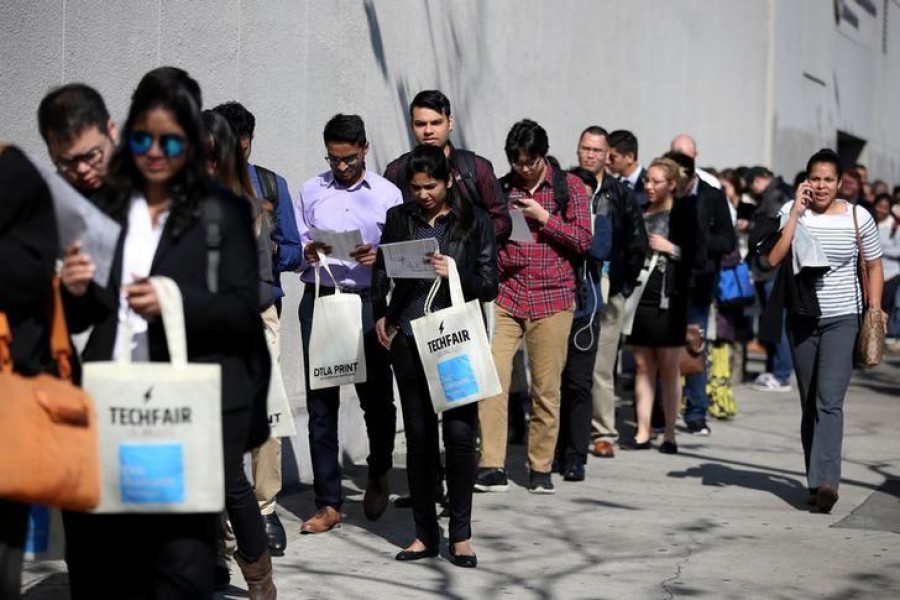The US economy created more jobs than expected in June, but steady wage gains pointed to moderate inflation pressures that should keep the Federal Reserve on a path of gradual interest rate increases this year.
Nonfarm payrolls rose by 213,000 jobs last month as manufacturers stepped up hiring, the Labor Department said on Friday. The economy added 37,000 more jobs in April and May than previously reported. It needs to create about 120,000 jobs per month to keep up with growth in the working-age population.
“Overall the report is good news insofar as it suggests the economy still has some capacity to grow at an above-trend pace without generating much inflationary pressure,” said Michael Feroli, an economist at JPMorgan in New York. “Similarly, it should ease the concerns of the hawks (at the Fed) who worry that the Fed’s rate hike campaign is behind the curve.”
The report showed strength in the economy before a trade war started between the United States and China, which analysts warned could slow hiring, especially in the manufacturing sector. The US and China slapped tit-for-tat duties on $34 billion worth of the other’s imports on Friday.
Washington is also engaged in fights with other major trade partners, including Canada, Mexico and the European Union after President Donald Trump imposed tariffs on steel and aluminum imports. Trump argues that the duties are necessary to protect domestic industries from what he says is unfair competition from foreign manufacturers.
Economists have warned the tit-for-tat tariffs could disrupt the supply chain, undermine business investment and raise prices for consumers, and wipe out the stimulus from a $1.5 trillion tax cut package that came into effect in January.
The unemployment rate rose to 4.0 per cent in June from an 18-year low of 3.8 per cent in May as 601,000 job seekers entered the labour force in a sign of confidence in the labour market. That was the first increase in the jobless rate in 10 months.
The labour force participation rate, or the proportion of working-age Americans who have a job or are looking for one, rose to 62.9 per cent last month from 62.7 per cent in May. It had declined for three straight months.
Average hourly earnings gained five cents, or 0.2 per cent in June after increasing 0.3 per cent in May. That kept the annual increase in average hourly earnings at 2.7 per cent. But with a record 6.7 million unfilled jobs in April, economists are confident that wage growth will accelerate later this year.
June’s moderate wage growth should, for now, allay fears of the economy overheating. The Fed’s preferred inflation measure hit the central bank’s 2.0 per cent target in May for the first time in six years. Economists expect inflation will hover around its target because of labour market tightness.
“Wages could rise at a faster pace in the future as the economy is humming and the labor market is tight,” said Sung Won Sohn, chief economist at SS Economics in Los Angeles. “However, the ongoing trade war with China and our allies could hurt investment spending and hold back job and wage gains.”
The dollar fell to a three-week low against a basket of currencies on the employment report. Prices for longer-dated US Treasuries rose. Stocks on Wall Street were trading higher, with the S&P 500 and the Nasdaq indexes touching two-week highs.
Robust economy
Economists polled by Reuters had forecast nonfarm payrolls increasing by 195,000 jobs last month and the unemployment rate steady at 3.8 per cent.
Minutes of the Fed’s June 12-13 policy meeting published on Thursday were upbeat on the labour market. The US central bank raised interest rates last month for the second time this year and has projected two more rate hikes by year end.
A broader measure of unemployment, which includes people who want to work but have given up searching and those working part-time because they cannot find full-time employment, rose to 7.8 per cent last month from a 17-year low of 7.6 per cent in May.
The employment report together with data from the Commerce Department showing the trade deficit narrowed 6.6 per cent to a 1-1/2-year low of $43.1 billion in May reinforced expectations of robust economic growth in the second quarter.
Gross domestic product growth estimates for the April-June period are as high as a 5.0 per cent annualized rate, more than double the 2.0 per cent pace logged in the first quarter.
But the Trump administration’s “America First” trade policy, is casting a pall over the outlook for the rest of the year and into 2019. Manufacturing, construction and other sectors heavily reliant on trade are seen taking a big hit from the tariff wars.
“Fortunately the economy has a good head of steam going into a period of significant uncertainty in terms of the impact of higher tariffs across a broad range of imports and exports,” said Brian Bethune, chief economist at Alpha Economic Foresights in Boston. “Unequivocally, this is a nightmare situation.”
Manufacturers hired 36,000 workers in June, the most in six months, adding to the 19,000 jobs created in May. The factory jobs were concentrated in the automobile industry, which had seen a decline in employment in May after a fire at a major parts supplier disrupted production, Reuters reported.
Construction payrolls rose by 13,000 last month after increasing by 29,000 jobs in May. There were gains in professional and business services employment as well as leisure and hospitality. But retailers cut 21,600 jobs last month, after boosting payrolls by 25,100 in May.
Government payrolls increased by 11,000 jobs in June, buoyed by local government hiring.


